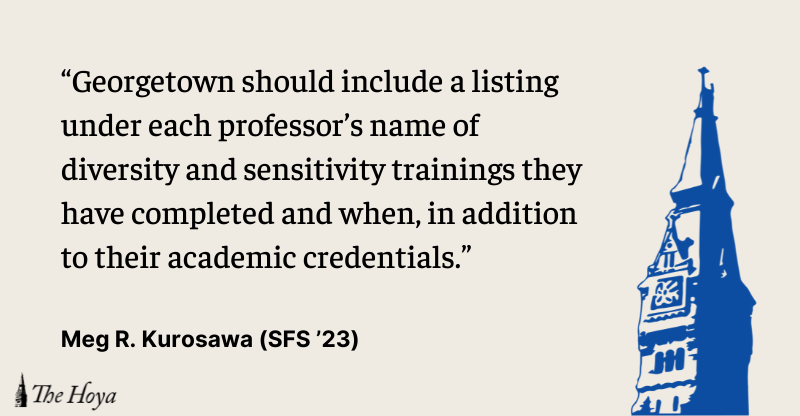From being asked about their immigration status to experiencing racist and stereotypical jokes in classrooms, BIPOC students at Georgetown University experience discrimination in spaces in which they’re supposed to feel safe. Instagram accounts like @deargeorgetown document the pervasiveness of racism on campus, making it evident Georgetown professors have failed to create secure and inclusive learning environments for BIPOC students. The university must protect its BIPOC students by strengthening faculty diversity training requirements and listing their diversity training credentials during course registration.
Although some instances of racial aggression against BIPOC students at Georgetown have been captured on video and featured on national news, many other incidents go unnoticed or unacknowledged by the university, its faculty and most students.
Many students have called for the university to conduct mandatory faculty training on race. However, a significant number of professors have not undergone or refuse to undergo the existing diversity and sensitivity training programs currently available to them, according to Vice Dean for Diversity, Equity and Inclusion in the School of Foreign Service Scott Taylor, who commented on the matter at an informal meeting with Asian American and Pacific Islander students I attended Sept. 24.
In addition, the Office of Institutional Diversity, Equity & Affirmative Action recently emphasized the importance of the 2020 Cultural Climate Survey results, which were released in April 2021. The survey included questions on students’ sense of belonging, experiences involving bias and campus accessibility.
In an update to students on the survey results, the university shared that the survey “revealed trends that require serious engagement—particularly concerns expressed by our Black students—and the data will help inform how we can enhance and build meaningful programs and support systems to ensure a more inclusive campus community for all,” Vice President for Diversity, Equity, Inclusion Rosemary Kilkenny and former Vice President for Student Affairs Dr. Todd Olson wrote in the email.
White students consistently reported more positive experiences and perceptions of the campus environment compared to students of color, according to the findings. While almost 80% of white undergraduate students agreed or strongly agreed that instructors were effective at creating environments where they felt welcomed, only 37.4% of Black or African American students shared this agreement. These statistics, as well as others in the climate survey results, reveal a serious and urgent concern over inclusive pedagogy.
Georgetown’s Center for New Designs in Learning and Scholarship (CNDLS) currently collaborates with many university divisions to encourage faculty to critically review and update instructional practices. CNDLS’ consultation services for faculty looking to update their curriculum to maintain up-to-date pedagogy can be a promising solution for implementing more inclusive, student-centered teaching. Such resources, in addition to diversity and sensitivity trainings, are readily available to Georgetown faculty, who should take advantage of them.
Furthermore, there is no university-mandated source for students that states whether professors have completed diversity and sensitivity trainings that could be useful during course registration. Students rely on word of mouth and review websites like Rate My Professors to avoid professors with past incidents of racial aggressions.
However, unofficial sources that are not institutionally organized are not enough. During course registration, Georgetown should include a listing under each professor’s name of diversity and sensitivity trainings they have completed and when, in addition to their academic credentials.
This feature would not only provide BIPOC students with useful information during course registration, but it would also create transparency and accountability between the university administration, faculty and students. Georgetown lists “continued training opportunities for staff and faculty on the role of managing implicit bias in our community” as one of its “Commitments to Improving Equity and Access” on the school’s main website. The administration should uphold this commitment and follow through with decisive, deliberate accountability and transparency.
Meg R. Kurosawa is a junior in the School of Foreign Service.









